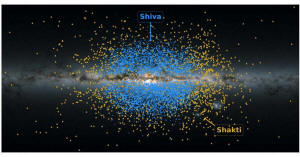Scientists identify Milky Way's ancient building blocks Shakti and Shiva
 Send a link to a friend
Send a link to a friend
 [March 23, 2024]
By Will Dunham [March 23, 2024]
By Will Dunham
WASHINGTON (Reuters) - Astronomers have identified two ancient streams
of stars - named after the Hindu deities Shakti and Shiva - that appear
to be among the Milky Way's earliest building blocks, offering new
insight into how our galaxy came together long ago.
These structures, found using observations from the European Space
Agency's Gaia space telescope, may be relics of two distinct galaxies
that merged roughly 12 billion years ago with the Milky Way's primordial
pieces during the galaxy's infancy, the scientists said.
Shakti and Shiva are comprised of stars with similar chemical
compositions that formed 12-13 billion years ago, the researchers said.
Each of the structures has a mass about 10 million times greater than
our sun.
In Hinduism, the union between Shiva and Shakti gave rise to the cosmos.
Identifying the Shakti and Shiva structures has helped to bring the
Milky Way's turbulent earliest stages into focus.
"Broadly, our study addresses a very fundamental question of modern
astrophysics: how do galaxies form in our universe?" said astronomer
Khyati Malhan of the Max Planck Institute for Astronomy in Germany, lead
author of the research published this week in the Astrophysical Journal.

The Milky Way is a large spiral-shaped galaxy populated by hundreds of
billions of stars whose disk measures approximately 100,000 light years
in diameter. A light year is the distance light travels in a year, 5.9
trillion miles (9.5 trillion km). Stars, gas and dust extend from the
galactic center in lengthy spiraling arms, with our sun residing on one
of those.
"Specifically, our study potentially provides an understanding of the
Milky Way's very initial stages of formation by identifying two star
structures that coalesced very early on, perhaps the last event from the
proto-Milky Way before disk formation commenced," Malhan said.
Gaia, launched in 2013, is assembling the largest and most precise
three-dimensional map of the Milky Way, measuring the positions,
distances and motions of stars. This data helped the researchers to
detect the presence of Shakti and Shiva through properties shared by
their stars.
[to top of second column]
|

An illustration shows a view of the Milky Way band across the sky,
with yellow dots showing the location of the stars from the Shakti
ancient stream of stars and blue dots showing the location of the
stars from the Shiva ancient stellar stream. ESA/Gaia/DPAC/K. Malhan/Handout
via REUTERS

The Big Bang event that initiated the galaxy occurred about 13.8
billion years ago. The infant Milky Way is believed to have
possessed an irregular form, with long filaments of gas, dust and
stars coalescing and weaving together.
Shiva and Shakti are now situated within approximately 30,000 light
years of the galactic center. Shiva's stars are a bit closer to this
center than Shakti's stars.
The study builds on another recent discovery. In 2022, scientists
using Gaia data identified what they called the "poor old heart" of
the Milky Way, a population of stars also dating to the earliest
history of the galaxy and similarly located within the galactic
core.
The stars that make up Shiva and Shakti differ in composition from
most of the galaxy's other stars.
They are called "metal poor" because they possess lesser amounts of
heavier elements - iron, carbon, oxygen and others. These heavier
elements were first forged inside the universe's earliest
populations of stars and then blasted into space when those stars
exploded at the end of their life cycles.
"Ideally, we want to trace the formation and evolution of the Milky
Way starting from the beginning of it until the present day - like
playing a 13 billion-years-long movie. But this is difficult,
especially when we try to study and unravel the very early phases of
our galaxy, say about 11-12 billion years ago," Malhan said.
"At present, we have only a broad brush understanding of the Milky
Way's formation and evolution, and future Gaia surveys - in
combination with other surveys - will shed more light on this."
(Reporting by Will Dunham; Editing by Rosalba O'Brien)
[© 2024 Thomson Reuters. All rights reserved.]This material
may not be published, broadcast, rewritten or redistributed.
Thompson Reuters is solely responsible for this content.
 |